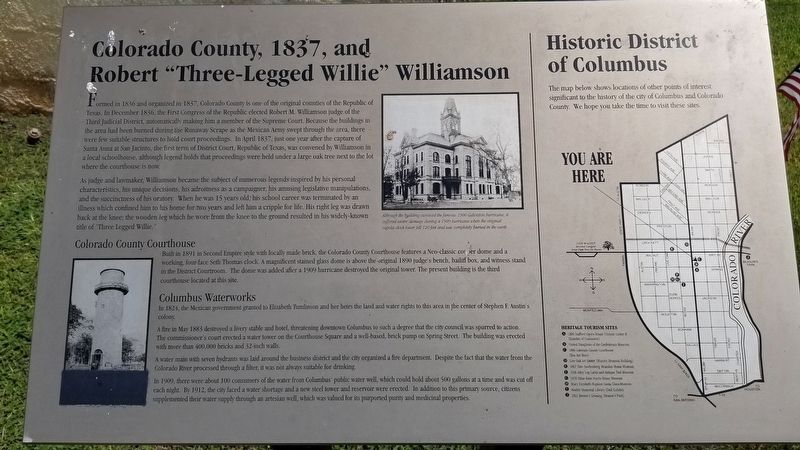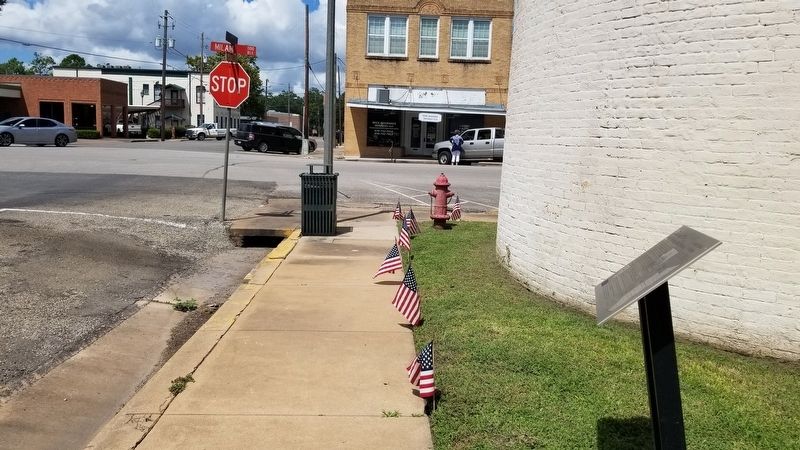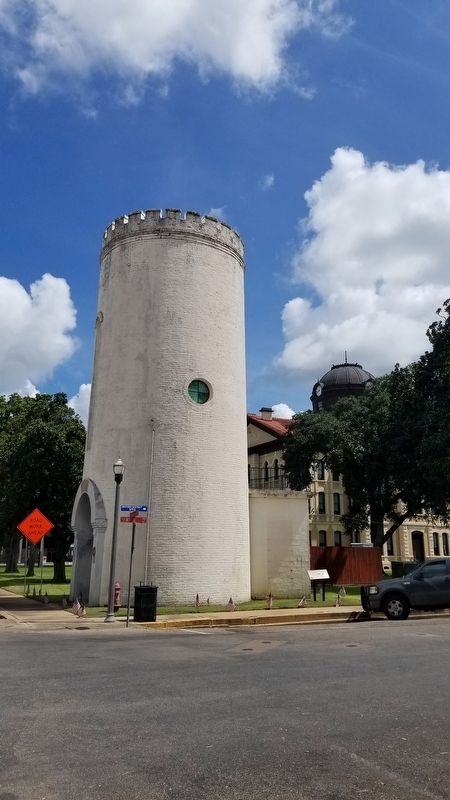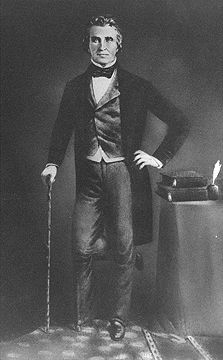Columbus in Colorado County, Texas — The American South (West South Central)
Colorado County, 1837, and Robert "Three-Legged Willie" Williamson
Inscription.
Formed in 1836 and organized in 1837, Colorado County is one of the original counties of the Republic of Texas. In December 1836, the First Congress of the Republic elected Robert M. Williamson judge of the Third Judicial District, automatically making him a member of the Supreme Court. Because the buildings in the area had been burned during the Runaway Scrape as the Mexican Army swept through the area, there were few suitable structures to hold court proceedings. In April 1837, just one year after the capture of Santa Anna at San Jacinto, the first term of District Court, Republic of Texas, was convened by Williamson in a local schoolhouse, although legend holds that proceedings were held under a large oak tree next to the lot where the courthouse is now.
As judge and lawmaker, Williamson became the subject of numerous legends inspired by his personal characteristics, his unique decisions, his adroitness as a campaigner, his amusing legislative manipulations, and the succinctness of his oratory. When he was 15 years old, his school career was terminated by an illness which confined him to his home for two years and left him a cripple for life. His right leg was drawn back at the knee; the wooden leg which he wore from the knee to the ground resulted in his widely-known title of "Three Legged Willie".
Colorado County Courthouse
Built in 1891 in Second Empire style with locally made brick, the Colorado County Courthouse features a Neo-classic copper dome and a working, four-face Seth Thomas clock. A magnificent stained glass dome is above the original 1890 judge's bench, bailiff box, and witness stand in the District Courtroom. The dome was added after a 1909 hurricane destroyed the original tower. The present building is the third courthouse located at this site.
Columbus Waterworks
In 1824, the Mexican government granted to Elizabeth Tumlinson and her heirs the land and water rights to this area in the center of Stephen F. Austin's colony.
A fire in May 1883 destroyed a livery stable and hotel, threatening downtown Columbus to such a degree that the city council was spurred to action. The commissioner's court erected a water tower on the Courthouse Square and a well-based, brick pump on Spring Street. The building was erected with more than 400,000 bricks and 32-inch walls.
A water main with seven hydrants was laid around the business district and the city organized a fire department. Despite the fact that the water from the Colorado River processed through a filter, it was not always suitable for drinking.
In 1909, there were about 100 consumers of the water from Columbus' public water well, which could hold about 500
gallons at a time and was cut off each night. By 1912, the city faced a water shortage and a new steel tower and reservoir were erected. In addition to this primary source, citizens supplemented their water supply through an artesian well, which was valued for its purported purity and medicinal properties.
Caption
Upper middle: Although the building survived the famous 1900 Galveston hurricane, it suffered severe damage during a 1909 hurricane when the original cupola-clock tower fell 120 feet and was completely buried in the earth.
Map
Right: Historic District of Columbus
The map below shows locations of other points of interest significant to the history of the city of Columbus and Colorado County. We hope you take the time to visit these sites.
Topics. This historical marker is listed in these topic lists: Disasters • Industry & Commerce • Law Enforcement • Settlements & Settlers. A significant historical month for this entry is April 1837.
Location. 29° 42.331′ N, 96° 32.417′ W. Marker is in Columbus, Texas, in Colorado County. Marker is at the intersection of Spring Street and Milam Street, on the right when traveling west on Spring Street. The marker is located in front of the large historic water tower. Touch for map. Marker is in this post office area: Columbus TX 78934, United States of America. Touch for directions.
Other nearby markers.
At least 8 other markers are within walking distance of this marker. Old Stafford Opera House (within shouting distance of this marker); The Rangers of Austin's Colony (within shouting distance of this marker); Stafford-Miller House (within shouting distance of this marker); Tumlinson Family (within shouting distance of this marker); Colorado County Courthouse (within shouting distance of this marker); Colorado County War Memorial (within shouting distance of this marker); Ehrenwerth-Ramsey-Untermeyer Building (within shouting distance of this marker); a different marker also named Colorado County (within shouting distance of this marker). Touch for a list and map of all markers in Columbus.
Also see . . . Williamson, Robert McAlpin [Three Legged Willie] (ca. 1806–1859).
After his defeat in the race for Congress in 1850, he retired to his farm near Independence and devoted himself to the education of his children and preparations of materials for writing a history of events in Texas leading up to the Texas Revolution. He was an unsuccessful candidate for lieutenant governor in 1851. In 1857 an attack of illness affected his mental brilliance, which was further impaired by the death of his wife in 1858. From these combined shocks his mind never entirely recovered. He died at the home of his father-in-law in Wharton on December 22, 1859. Williamson County, established in 1848, was named for R. M. Williamson. Source: The Handbook of Texas(Submitted on August 14, 2021, by James Hulse of Medina, Texas.)
Additional commentary.
1. How Robert Williamson got the nickname of Three-Legged-Willie
At the age of fifteen, he contracted tuberculous arthritis that caused his right leg to permanently stiffen at a 90 degree angle. In order to walk, a wooden leg had to be fastened to his knee. Because of this, he later acquired the nickname "Three-Legged-Willie".
Source: Wikipedia
— Submitted August 14, 2021, by James Hulse of Medina, Texas.
Credits. This page was last revised on August 14, 2021. It was originally submitted on August 13, 2021, by James Hulse of Medina, Texas. This page has been viewed 275 times since then and 24 times this year. Photos: 1, 2, 3, 4. submitted on August 14, 2021, by James Hulse of Medina, Texas.



